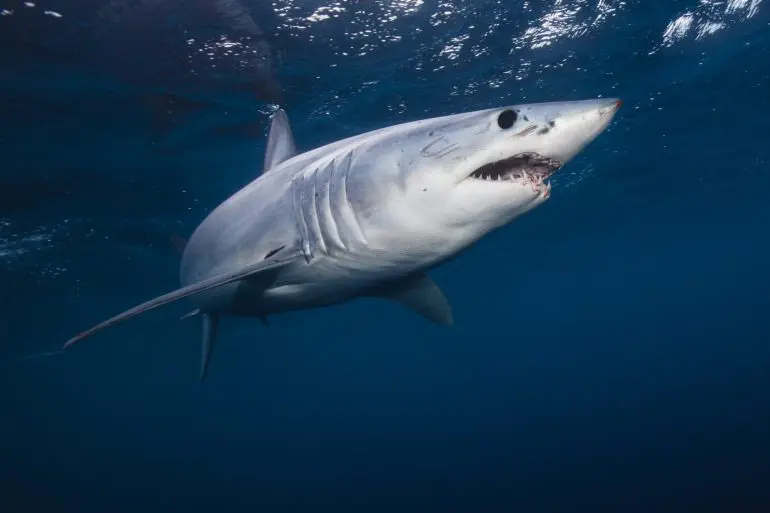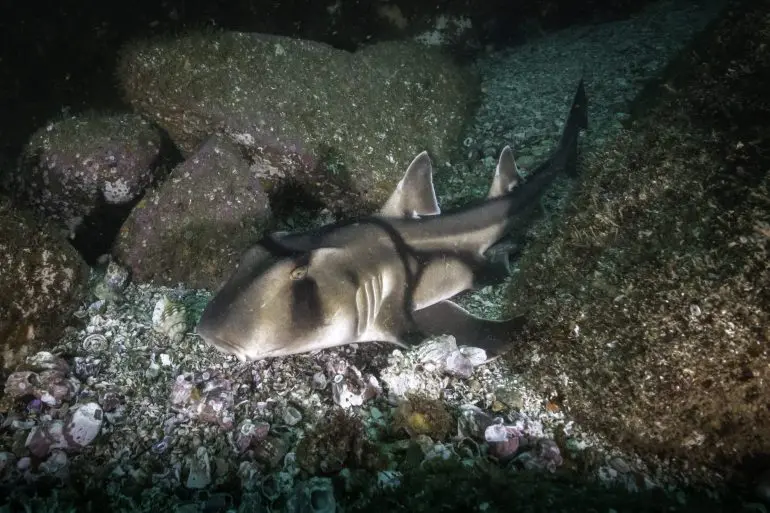It’s impossible to know with absolute certainty how many different types of sharks there are. They have been around for over 450 million years (longer than trees and dinosaurs) and in that time, thousands of shark species have come and gone.
Others have developed over millions of years and split off into different species and there are new types of sharks being discovered every year.
How many different Types of Sharks are there?

Bull shark (Carcharhinus leucas), searching for food (Photography by George Karbus Photography via Getty Images)
According to the latest data, there are approximately 520 described species of shark on record.
Sharks have long been the victims of bad press but they are remarkable creatures with fascinating traits, qualities and behaviours and they play an important role in our marine ecosystems.
While we tend to think of sharks as huge, terrifying beasts with razor-sharp teeth, the truth is a little less ‘Hollywood’. Even in terms of the size of shark species, over 75% are no bigger than the average human adult and 100 or more of the smallest sharks are under 60cm long.
While the exact number of shark types is the subject of serious debate, they can all be classified into eight specific groups of sharks.
The Different Shark Types

Caribbean shark's wide mouth, Carcharhinus perezi, Bahamas (photo: getty images)
Sharks come in all shapes and sizes, from the 17m whale shark to the 20cm dwarf lanternshark and from bizarre-looking sharks such as the hammerhead to the horrendously ugly goblin shark.
However big, small or strange looking they are, they all have shared characteristics –
- A skeleton made entirely of cartilage (sharks in fact have no bones)
- Between five and seven gills
- Rigid fins
- Dermal denticles (or placoid scales), tiny, teeth-like ridges on their outer skin that feels like sandpaper
- Electroreceptors enabling them to sense electric fields in the water
Each one of the 520 or so types of sharks fits neatly into one of eight categories, known as orders. Here, we’ll take a closer look at each one.
Carcharhiniformes

A great Hammerhead shark lurking (Photo: Getty Images)
This is the most common order which includes around half of all sharks.
Characteristics: Five gills, two dorsal fins, an anal fin and a membrane over their eyes which protects them from damage. They have longer snouts and wide mouths with sharp teeth positioned behind the eyes.
Notable species: Hammerhead shark, tiger shark, blue shark, bull shark, blacktip reef shark, lemon shark, dusky shark
Heterodontiformes

Zebra shark on the ocean bed (Photography via Getty Images)
Usually small and rather odd-looking, there are only nine known species.
Characteristics: Short shouts and large brows with small spiracles to help them breathe. They are primarily nocturnal hunters with both sharp and flat teeth to help them eat hard-shelled prey.
Notable species: Zebra bullhead shark, Port Jackson shark, horn shark, Galapagos bullhead shark
Hexanchiformes

Frilled shark showing it's teeth and gills. (Photo by Awashima Marine Park via Getty Images)
Considered to be the most primitive group of sharks alive, they favour the deep, cold waters of the Atlantic, Indian and Pacific oceans.
Characteristics: Either six or seven gills and one dorsal fin and they are ovoviviparous, meaning their eggs hatch inside the female and the pups are born alive.
Notable species: Frilled shark, broadnose sevengill shark, bluntnose sixgill shark, cow shark
Lamniformes

Underwater view of shortfin mako shark (Photography by Richard Robinson via Getty Images)
Also known as mackerel sharks, this order contains some of the most well-known apex predators in the sea and tend to be the most ‘typical’ types of sharks.
Characteristics: Five gills, two dorsal fins and an anal fin. They have rows of very sharp teeth and the ability to maintain a higher body temperature than the waters in which they are swimming.
Notable species: Great white shark, basking shark, shortfin mako shark, porbeagle shark, goblin shark, thresher shark
Orectolobiformes

Epaulette Shark surrounded by coral (Photography by Hal Beral via Getty Images)
Perhaps the most diverse order of shark types, they range from the 17m whale shark to the 30cm barbelthroat carpet shark.
Characteristics: Five gill slits and two spineless dorsal fins, their mouths are placed at the very front of their heads and don’t extend behind the eyes. They are commonly known as carpet sharks since many of them are patterned.
Notable species: Wobbegong shark, zebra shark, epaulette shark, nurse shark, whale shark, bluegrey carpet shark
Pristiophoriformes

A sixgill shark swimming in deep water (Photography by Stuart Westmorland via Getty Images)
Also known as sawsharks, these groups of sharks tend to inhabit tropical coastal waters and are the easiest to identify.
Characteristics: All have long, saw-like snouts edged with sharp teeth, five or six gills, two dorsal fins and wide pectoral fins. They also give birth to live young.
Notable species: Japanese sawshark, sixgill sawshark, African dwarf sawshark
Squaliformes
There are around 126 different shark species and they are found in virtually every marine habitat. They vary from the dwarf lanternshark – the world’s smallest shark – to the Greenland shark, the world’s oldest known vertebrate with some estimated to be around 500 years old.
Characteristics: Long snouts and short mouths, five gills, two dorsal fins and some are bioluminescent.
Notable species: Cookiecutter shark, Greenland shark, gulper shark, pygmy shark, spiny dogfish, bramble shark
Squatiniformes

Tasselled wobbegong Shark lingering on the seabed (Photography via Getty Images)
Limited to 13 species all in the same family, they are often confused with skates or rays and are more commonly known as angelsharks. They live on the ocean floor.
Characteristics: Flat bodies, short snout, nasal barbels and very wide, horizontal pectoral fins.
Notable species: Sawback angelsharks, clouded angelsharks, pacific angelsharks.
Fascinating, Complex Creatures

A port Jackson shark drifts among the rocks (Photography via Getty Images)
Of the hundreds of different types of sharks in the sea, they all have one thing in common – they are fascinating, complicated creatures vital for ocean health and for maintaining a balanced food chain.












